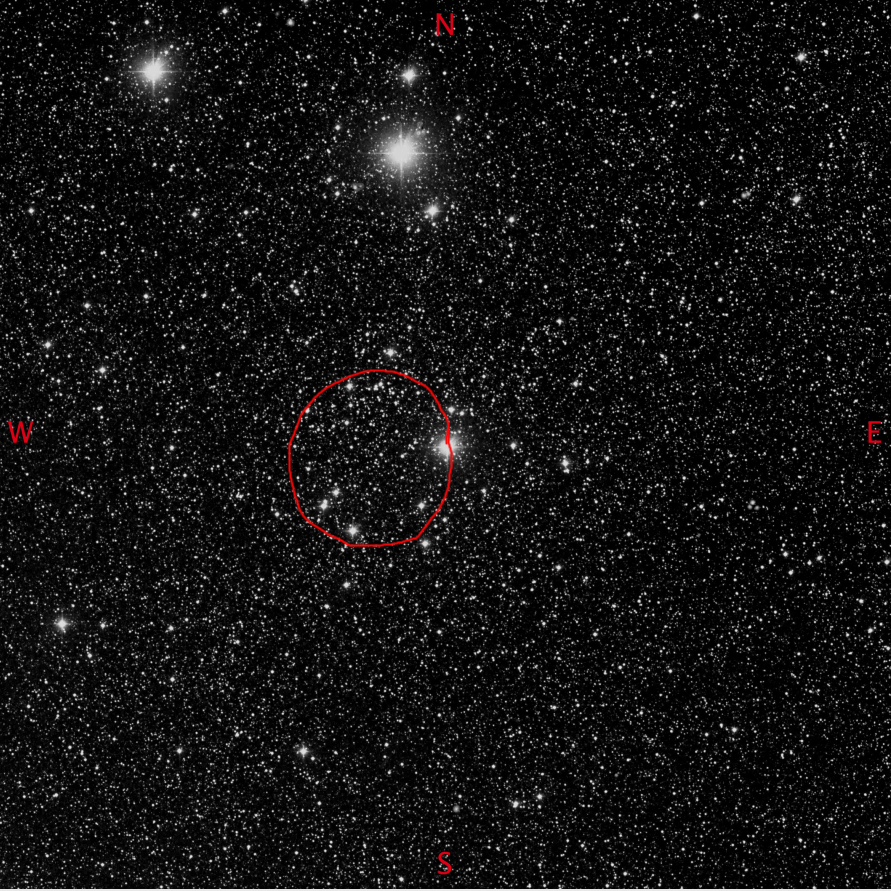Well the clear nights are coming thick and fast and although this was a weekday, I managed to stay awake by the time it started to get dark. However, I think I started to observe a little too early, as the first couple of objects were not seen. Another half an hour might have made all the difference.
Session Data
- Date: 24/06/2014
- Time: 22:28 – 00:35 UT
- Seeing: I Perfectly Stable,
- Transparency: Clear. Temp: 12C,
- Humidity 91%,
- Wind Speed: 7mph
Caldwell 6: NGC6543
Not Found
Caldwell 3: NGC4236
Not Found
Caldwell 37: NGC6885, Collinder417

In the Altair Astro 250mm, Plossl 40mm, 51 X, 52′, West is to the 8 O’Clock.
To the North and just inside the FOV is the 5.5 mag star 19 Vul.
There are actually two clusters here in the FOV. NGC6885 is the larger of the two and embedded within the outer edge of it, is another Cluster – Collinder416. NGC6885 appears to be made up with a number of stars that form a Christmas tree triangular shape ( Marked red in the Image). The base is aligned N/W – S/E and the point of the triangle goes up towards the N/E. The whole cluster takes up about 1/2 the FOV – 25 arc mins.
Offset from the centre of NGC6885 and a little to the N/W is another smaller cluster Collinder416 (Marked Green in the image). This is orientated N/E – S/W and appears to be rectangular in shape with a size of about 5 arc min long. The stars within this cluster seem fainter and more condensed than NGC6885.
Collinder416
See observation of NGC6885
CR399
In the 10x60mm Finder, 23mm Reticule, 10 X, 5.1°, West is to the 2 O’Clock. Nothing much to say as this is the only scope fitted to the mount at the time that would fit the whole asterism in. Looked nice though with the arm of the hanger running E/W with the hanger pointed down towards the South.
Caldwell 34: NGC6960
In the Altair Astro 250mm, Plossl 40mm, 51 X, 52′, West is to the 9 O’Clock.
Well I saw it, but not very much of it. 52 Cyg blasting away at 4.2 mag seems to illuminate a section about 8 arc mins around the nebula. I tried upping the mag by switching to Altair Astro 250mm, UWA 18mm, 113 X, 35.6′ and it was very difficult tracing the nebula much further as it headed SSE and to the North. Perhaps I would have seen more had I used the OIII filter, but didn’t remember that this object would be enhanced by its use. Need to try this next time.
NGC6995
Not Found
Caldwell 33: NGC6992
Not Found
Now all this looks very straightforward…..BUT, when I read the various observing notes concerning NGC6885 after I made my observation, my brain started to hurt.
I first went to Kepple and Sanner’s ‘The Night Sky Observers Guide’ where it says that ‘NGC6885 and NGC6882 are not readily distinguishable as separate entities’ . Wait a minute! According to Skytools 3, NGC6882 is 20 arc mins to the North, where I observed the bright star 20 Vul, which didn’t seem to be embedded within any kind of cluster. So why are Kepple and Sanner saying these are ‘not readily distinguishable’
I then fired up Astroplanner and it plots NGC6885 inside and to the centre of the much larger cluster NGC6552. To confuse things even further, if I overlay the Collinder catalogue over the NGC one, Collinder416 – where I observed it, is also listed as being NGC6882. I now have two NGC6882’s plotted on the same chart with their respective centres about 6 arc mins apart!
The NGC Catalogue says NGC 6882 is 16 arc mins in diameter and the Collinder catalogue says CR416 which says it is also NGC6552 is only 10 arc min in diameter.
All very confusing and contradictory. It’s not until I read Stephen O’Meara’s Book ‘The Caldwell Objects’ that things start to become clearer. I do urge you to actually read the six and a half pages on Caldwell 37, as it shines a little light as to why NGC6552 is a major source of problems for all the various star charts and object catalogues since both were observed by William Herschel on 9th and 10th September 1784.